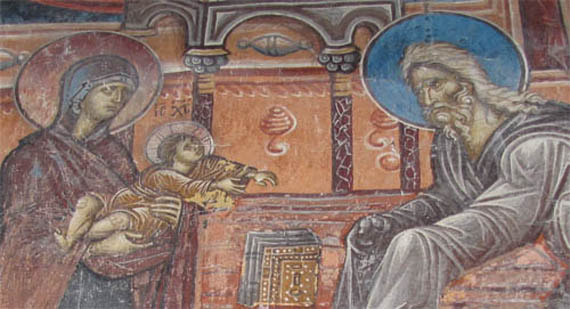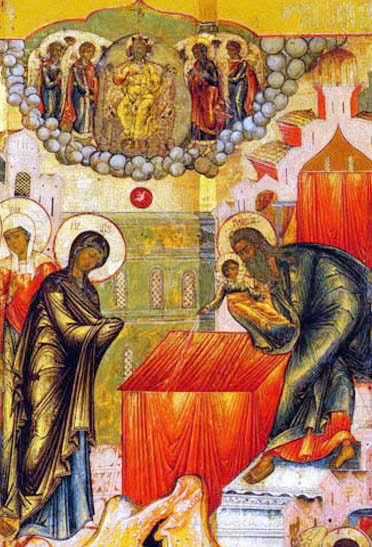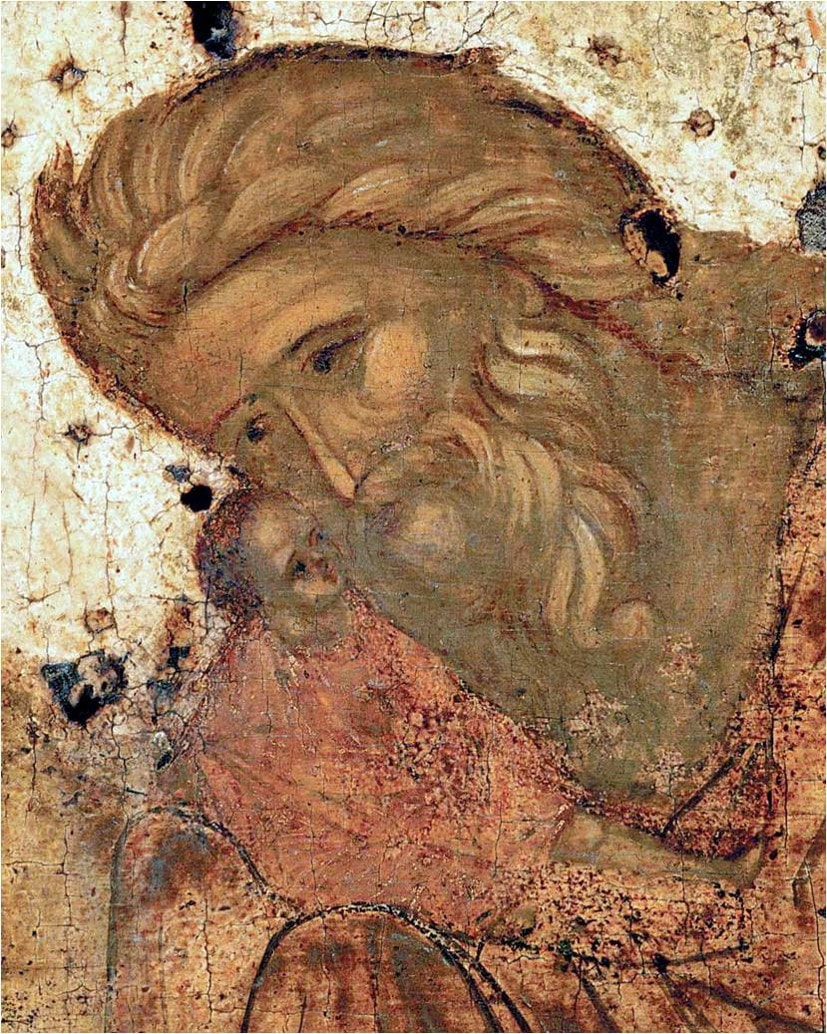|
Now lettest Thou Thy servant depart in peace, according to Thy Word, for mine eyes have seen Thy salvation which Thou hast prepared before the face of all peoples, a Light to enlighten the gentiles, and the glory of Thy people Israel. (The Canticle of Simeon, Luke 9:29-32) The first words of the canticle, pronounced by Simeon when he sees the Child, are an exclamation of joy at his approaching death. It is an answer to the promise made by the Holy Spirit to the old man: he is not to die before seeing the Christ of the Lord. In one of the Psalms of the Ascent which we sing during Vespers in Lent, the psalmist sings: (click below to read more:) “I wait for the Lord, my soul waits, and in His word I hope; my soul waits for the Lord more than the watchman for the morning, more than the watchman for the morning. O Israel, hope in the Lord.” (Ps 129:5-7) Simeon is the last “watcher” (vigilant) of Israel (remember also Habakuk, who watches by night, in the 4th Ode of the Canon): he looks out for the dawn, and he finally sees the day begin to break and recognises the light of the “Sun of Righteousness.” The Canticle of Simeon, known as Nunc Dimittis (Now lettest Thou, Lat.) is one of the three New Testament canticles, and it is recited at the end of each Vespers. At Vespers we experience the long period of expectation for Christ in the Old Testament. The service begins with Psalm 103 – an account of creation. Then we read other psalms and scriptural passages indicating Israel's hope. This expectation is fulfilled in the encounter between the Old and New Covenants, an encounter realised in the person of Christ. As the light of evening comes and the day draws to an end, we contemplate a different light, the joyful Light, which Simeon meets in the Temple: “O joyful light, Thou Jesus Christ!...” Although we see the Elder Simeon opening his arms to receive the Divine Child, it is actually the Child, Who sustains all creation, Who “stretches out His hand to Adam” (Canon, Ode 3, troparion) At the Festal Vespers of the Encounter in the Temple, we hear three Old Testament readings. One of them is Isaiah's vision of God (Isaiah 6:1-12) Simeon, like Moses on Sinai, meets God face to face. But Moses saw God in the cloud and had to cover his face, so bright was the light of God. Simeon, however, took God in his arms. It seems that the rule to see God in face has been lifted after the birth of Christ. Has man become more worthy to see God? Is he pure enough to meet Him? Humanity in the New Testament is neither more worthy nor more pure than in the Old Testament, but it receives purification through Christ Himself, and Christ has the power to remove all stains. This is the reason why, at this Feast of the Encounter, the Church lets us hear the passage from Isaiah describing his vision in the temple (Is. 6:1-12). When Isaiah saw the Lord seated on a raised throne, and contemplated His glory, when he heard the Thrice-Holy song of the angels, he exclaimed: “Woe is me! For I am lost; for I am a man of unclean lips... For my eyes have seen the King, the Lord of hosts!” (Is.6:5). A seraphim was sent to him bearing a burning coal taken from the altar with tongs in order to purify the lips of the prophet. After distributing Holy Communion to the faithful, the priest pronounces these words: “Behold, this has touched your lips and your guilt has been taken away and your sin has been forgiven." Another Old Testament reading is about The burnt offering (Leviticus 12): ‘If a woman conceived and bore a male child, (6)When the days of her purification are fulfilled, she is to bring to the priest a lamb of the first year as a whole burnt offering, and a young pigeon or a turtledove as a sin offering, to the door of the tabernacle of testimony. (8) But if she is unable to afford a lamb, she may bring two turtledoves or two young pigeons—one as a whole burnt offering and the other as a sin offering. So the priest shall make atonement for her, and she will be clean.’ On the icon we see the righteous Joseph carrying two turtledoves. Yet, the spotless Virgin needs no purification. We also see there is no lamb. The absence of a lamb in the evangelist Luke's story and on the icon is no accident either, and it is not necessarily because of their poverty that “a victim is not brought”. Mary extends her arms, which are covered with a cloth. She offers the Child and gives Him to the Elder, who receives the Infant over the sacrificial altar. Jesus is the spotless Victim, pure and innocent, He is the “Lamb of God” offered as a sacrifice: “The pure Dove, the Ewe without blemish, brings the Lamb and Shepherd into the temple.” (Canon, Ode 9) Just as Abel was immolated in place of his lamb, just as Isaac was offered in sacrifice by his father, as the suffering servant of Isaiah allows himself to be led to the slaughter, a submissive and defenceless lamb, so today Jesus is brought to the Temple and received by the priest at the altar – a prophetic vision of his death on the Cross. Christ is also this living Coal which purifies, and the Virgin Mary is “the mystic tongs who hast conceived in thy womb Christ the live Coal." (Canon, Ode 9, troparion). “Christ once appeared to the divine Isaiah as a burning coal held by tongs. Now He is given to the elder by the hands of the Mother of God.” (Aposticha, tone 2) The Temple assumes its eternal dimension before the Creator, it becomes the true meeting place, a place of Encounter between God and His people! The altar on which the Lord is offered is the throne of God, that of the heavenly Jerusalem: “And between the throne and the four living creatures and among the elders, I saw a Lamb standing, as though it had been slain...” (Rev. 5:6) (excerpts from The Incarnate God – A Festal Catechesis) The Meeting of the Lord (from the Festal sermon by Fr Alexander Schmemann) “How striking and beautiful an image, the old man holding the Child in his arms, and how strange are his words: “For my eyes have seen Thy salvation . . .” Pondering these words we begin to appreciate the depth of this event and its relationship to us, to me, to our faith. Is anything in the world more joyful than an encounter, a meeting with someone you love? Truly, to live is to await, to look forward to the encounter. Isn’t Simeon’s transcendent and beautiful anticipation a symbol of this? Isn’t his long life a symbol of expectation, this elderly man who spends his whole life waiting for the Light which illumines all and the Joy which fills everything with itself? And how unexpected, how unspeakably good that the long awaited light and joy comes to the elderly Simeon through a child! Imagine the old man’s trembling hands as he takes in his arms the forty-day-old Infant so tenderly and carefully, his eyes gazing on the tiny being and filling with an outpouring of praise: “Now, You may let me depart in peace for I have seen, I have held in my arms, I have embraced the very Meaning of life.” Simeon waited. He waited his entire long life, and surely this means he pondered, he prayed, he deepened as he waited so that in the end his whole life was one continuous “eve” of a joyful meeting. Isn’t it time that we ask ourselves: what am I waiting for? What does my heart keep reminding me about more and more insistently? Is this life of mine gradually being transformed into anticipation, as I look forward to encountering the essential? These are the questions the Meeting poses. Here, in this feast, human life is revealed as the surpassing beauty of a maturing soul, increasingly liberated, deepened and cleansed of all that is petty, meaningless, and incidental. Even ageing and demise, the earthly destiny we all share, are so simply and convincingly shown here to be growth and ascent toward that one moment when with all my heart, in the fullness of thanksgiving, I say: “let me now depart.” I have seen the light which permeates the world. I have seen the Child who brings the world so much divine love and who gives Himself to me. Nothing is feared, nothing is unknown, all is now peace, thanksgiving, and love. This is what the Meeting of the Lord brings. It celebrates the soul meeting Love, meeting the One who gave me life and gave me strength to transfigure it into anticipation.” compiled and edited by Vera Davidova-Pote
0 Comments
Leave a Reply. |
Parish Blog
This mainly contains homilies and messages from our priests, although there is some scope to share thoughts and interesting articles which we may want to share with others Archives
October 2022
Categories |





 RSS Feed
RSS Feed